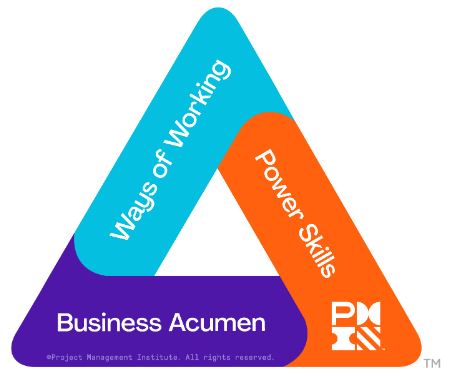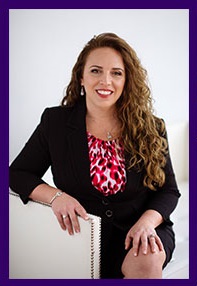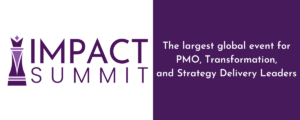
PMI Talent Triangle: Business Acumen (Strategic and Business Management)
Welcome to the PMO Strategies Podcast + Blog, where PMO leaders become IMPACT Drivers! Today, we are talking with one of my dearest friends, Mike Hannan. Mike and I have known each other for a very, very long time. He truly was a friend first, and then we found out how much we had in common with respect to helping organizations make a huge impact with PMO, project management, portfolio management. And both of us have a really strong passion in this space and have worked together on a lot of different projects, initiatives, workshops. Mike is one of the founding creators of Project Management for Change and the Project Management Day of Service. He is also one of the advisors for my company, PMO Strategies. I’ve known him much longer than I’ve even had the company. So he’s been an integral part in shaping the direction of my company, and what I’m all about, and how I’m delivering an impact for my community of IMPACT drivers. Mike is a leading edge-thinker and renegade, which I can totally vouch for, who believes that we all must do more to unleash our boundless potential and solve increasingly complex global issues. He envisions a community-centric, expert-guided, power-to-the-edge solution to most of these issues, which is super cool. For leaders and managers, this means open-platform approaches to innovating and sharing the most effective management practices. For consultants and other experts, this means that we are, too often, part of the problem, and need to be and do a much better job channeling our expertise in a way that delivers much greater impact. Laura Barnard: Can you tell us about what you are presenting in the PMO IMPACT Summit?
Mike: My first presentation at the Summit is called Finding the North Star, A Universal Approach to Resolving the Methodology Wars. And the idea here is, the methodology… It’s kind of like if you remember that old movie from the ’80s, where there’s a global thermonuclear war being launched by computers I think it’s Matthew Broderick playing the lead role. And in the end, the computer played tic-tac-toe to a draw, a million times in a row, before learning that the only way to win is not to play. My point is don’t play the methodology wars. There’s a better objective-driven approach that I’ll be sharing at the Impact Summit, and I’ll give everyone a little bit of a taste here. If you agree with my objectives, and you can lead yourself there, maybe you can come up with your own methodology following that objective-driven framework.
Laura: Yes. Yes, that’s great. Regardless of whatever the methodology is, getting out of this “us and them” mindset, and “you’re wrong because that’s the only way I can be right,” kind of thinking, and moving past that to the more important conversation that we should be having, and what that conversation looks like. Can you talk a little bit about your perspective on what that conversation should look like and what we should be doing anyway?
Mike: I think the best way to introduce it is, if you’re familiar at all with one of the major methodology wars that have been fought over the last 10 or 15 years, and that’s the whole Agile versus Waterfall debate.If you think about that for a moment, it’s all about, “Oh, my solution is better.” And it’s like, “Well, solution to what?” And so, too often, again, we’ve become so enamored of our own solutions, we forget to really talk about the problem. And while the problem may well be manifest in a patterned way, over and over, in lots of different organizations, and I do see that as a consultant, right? The reality is, every organization does have it a bit different. And if you just go forward with, “Hey, here’s how it works, go take the training and apply it verbatim,” you just asked those people to put on a straitjacket.
Laura: I think that that’s something that I’ve really pushed with my audience, and is threaded throughout my IMPACT Engine PMO training program. It’s been my experience as well, there’s been a lot of discussion around who’s methodology is right. And while we’re busy fighting over whether it’s Agile, or Waterfall, or any of these other millions of ways of getting projects done, our leadership teams are looking at us and saying, “Why are they wasting our time? This isn’t even the conversation we want to be having right now. I talked about that in some of the executive sessions we have as a part of the Summit. I figured it would be helpful for PMO leaders to hear directly from the C-suite, from some of these executives about what they’re thinking about and what their pain points are. And none of them are saying, “You must do Agile, and that’s the way to be successful,” or that you must do Waterfall, that’s not their point. They want good process discipline, they want transparency, they want the information they need to make educated, informed decisions. Those are the things we should be solving for them. And instead, all we do is spend time fighting and pointing fingers and spending a lot of cycles on the wrong conversation.
Mike: If you think about how this methodology war, the specific one, with Agile versus Waterfall, has played out, it ended up with essentially a truce being called. Where it says, “Look, we actually do have a way to understand both of these in context and we have some advice on when to use which, that there’s goodness in both.” The problem is the “I’ve already done it successfully, then so, I’m just going to do exactly what I did last time.” It never works. I have not ever seen it work a single time. Because you haven’t actually taken the time to understand your new problem space. It is a new context. You are a consultant like anyone, even if your title is CIO, you’re taking what you know from the past and you’re trying your best to apply it to your current context. That can’t just be done as a rinse and repeat. And every time I’ve seen it tried, it failed. The experienced CIO looks more bewildered than the poor newbie that tries it for the very first time and makes some mistakes, but maybe actually achieve something on their way too. This whole notion that we don’t know why things work when they work and why they don’t when they don’t, is a huge problem. And I think it’s because it’s detached from some just very simple common sense objectives that any good methodology should help you achieve. And that’s the real Northstar that I’ll be going into in the Summit presentation.
Laura: That’s awesome. I just want to touch on something. And before we dig into a little bit more about this, and your session, and some of the conversation we need to have around methodologies, one of the things that I always tell my students in my IMPACT Engine PMO training program, is that if they go into an organization, and they come in with guns blazing, “Okay, I’ve done this before, I’m a successful PMO leader, I have implemented PMOs here and there,” or X, Y, Z, “I’ve done this, I know the medicine you need to take,” I tell them, “Stop because you are 100% wrong.” Whatever it is, no matter what that medicine is, no matter how many times you’ve done it, it’s going to be different this time. And even if it’s not different, if you go in with that attitude, and you go in with the, “I already know the medicine you need to take, I already know how to solve your problems,” they’re not going to listen to you anyway. It should always, always, always start with shifting your mindset. That’s why I spend so much time at the beginning of this podcast talking about the mindset series and talking about those mindset shifts you’ve got to make. Once you do that, you start asking the questions. If you go in with this cookie cutter approach, then you’re going to fail, because no one’s going to buy in. It’s not their ideas, you haven’t assess the organization for the opportunities and places to make an IMPACT, you haven’t brought them along with the change, it’s not their experience, it’s yours. Whether you’re doing it as a PMO, or you’re talking about one of these PMO services, which is determining the right methodology, or if it’s methodology for projects, the first thing you do is figure out the business problem you’re trying to solve. And then you know the solution you need. And then you can identify the medicine that they need to take. The challenge we have is that a lot of PMO leaders, and project managers, and those that are responsible for project delivery, go in with a solution, they go in with the means and treat it as if it’s the end.
Mike: Right on. On the one hand, you could say, “Well, to say we have to start over from scratch and come in with a blank sheet of paper and pretend that all of our experiences up to that point are useless, that’s not true.” Instead the idea is “Well, you’ve got to keep an open mind and and keep somewhat of a blank sheet of paper. But obviously, we were hired for our experience, and our experience succeeding does matter. That’s maybe why they did hire us.” The key there is asking the question, I like to call it, the “how might we culture?” Any question that starts with “how might we” is going to be a good question. It might be, “Hey, I’m not clear on the business problems you actually want me to solve. How might we gain clarity?” “How might we formulate something very focused and priority-driven, that aligns with the strategic goals of the business and delivers the most value possible?” That’s an invitation to a conversation, it’s also an invitation to start maybe experimenting and learning through those experiments. “Hey, I think this might work since it worked in my last organization. Maybe we should try an experiment. What do you guys think?” “Oh, no, I don’t think that’ll work here. And, in fact, it could blow up in our faces and be a massive disaster.” “Oh, really? How might we mitigate the risk of that might happen?” Right there, I know if an organization is on the right track. If you just wander the hall for five minutes, and hear senior leaders, lower level, junior staff, middle management, asking themselves, “Hey, we really had a problem yesterday, how might we make sure that never happens again?” “Hey, I’m not sure if the new guy is really up to the task we’ve given him, how might we help them out and make sure we can all succeed here?” If you see that, and that’s an organization that actually is trying to stay very objective-driven, business-driven, purpose-driven, value-driven, with some ideas on what’s worked for them in the past, and a sense for why. And then when you’ve got that, then you don’t have a universe of possibilities that’s just too complex to try and explore. You got a very small subset. I’ve narrowed it down to exactly seven items that will be the topic of my Summit presentation. But maybe as a little teaser, right now, I think this whole agile, waterfall thing is all around… What really started it was, “Hey, sometimes the waterfall approach requires us to start over too much. And we go through months and months of work only to realize that we were walking down a blind alley. And now we’re going to go all the way back those months and start over.” That was way too much rework to stomach. Especially if the scope was fuzzy or just a few aspects that weren’t perfectly well nailed down, to say, “Well, if we know we’re not sure, okay, that’s fine, let’s put out something and see if we’re on the right track.” Because even if we have to rework our way through some of those iterative cycles, that might be the least overall rework in the end.
Laura: That makes perfect sense. I had been sharing with you that I had a similar experience before I even knew about the methodology wars. Back in the day, when I built my first PMO, I wasn’t interested in having methodology wars, but I knew that the traditional waterfall project approach wasn’t really going to fly in an environment where we were in the midst of the dot-com boom, and everyone’s going crazy, was trying to implement things so quickly, we had no choice but to iterate. It was iterate or die. My first PMO experience, back in 1999, I was implementing a combination of what is common sense, but at the time, and maybe still today, isn’t common practice. And that’s the challenge, is that if we get in the way of ourselves, if we are focused on which methodology we must follow, so we’re checking boxes, and everything looks exactly the same, we’re missing an opportunity to do a right fit and a right solution in the environment we’re in. You have a special blend of methodology that you’ve used over the years. And I do want to just say, if you can tell people how to find your book online so they can dig into more of that methodology, I think that’d be great.
Mike: So the title is the CIO’s Guide to Breakthrough Project Portfolio Performance. It’s available on Amazon in print, and Kindle, and even in English and Portuguese. When I wrote the book, that I thought was needed at the time, and I think it’s still unique in its place, is I had to read all these books to learn about agile and practice, practice it in the real world, and lean approaches, and critical chain, if folks are familiar with that. It took me a long time to assimilate onto something that seemed very straightforward and simple in the end, where I could just apply and get really great performance improvement. And I thought, “Well, if somebody had just written a book, that was like 150 pages, that had just given me the broad brushstrokes, I could have been fine.” So I decided to write that book.
Laura: What I think is so unique about it is that it takes the best pieces of different methodologies and mindsets and ideas and puts them together in something that actually really works in organizations. So I’d love for you to share a little bit about that.
Mike: Yeah, sure. So the methodology that I’ve coined, we call ACCLAIM. And that’s just a shorthand for Advanced, Critical Chain, Lean, Agile Integration Method. And the idea, as you said, is, why can’t we take the best techniques from the different bodies of knowledge, that have been proved out, and have helped organizations and leaders deliver big jumps in performance, and not just throw them all into the pot and stir and hope it’s coherent and cohesive, but actually pick and choose which things go best where, and which things combined well, in the most harmonious way, to turn into like a one, plus one, equals three, dynamic?
Laura: That’s really cool. I think that’s where a lot of people get stuck, is that it’s… and you’re going to talk about this as a part of the PMO IMPACT Summit, this whole methodology war, and us and them, and my way or the highway. And what you demonstrated is that you absolutely can pull the pieces and parts of a methodology that makes the most sense, and put them together in a way that helps you drive higher IMPACT and higher performance, and get things done, get projects delivered.
Laura: I’ve had several speakers that are part of the PMO IMPACT Summit, talking about things around attention, and focus, and multitasking. In fact, I just did a session today, with the author of Public Speaking Superheroes, Arvee Robinson. And she was talking about multitasking, and time management, and how our desire to multitask, which, of course, as you and I’ve talked about many times, really destroys focus and really destroys productivity. We were talking about that IMPACT on loyalty of your team when you’re running around crazy all the time and aren’t instilling focus yourself. It’s why my very first step in my IMPACT method is called instill focus. Because it is such a problem and it affects everything. It affects the loyalty of your team, it affects the ability to lead, it affects your ability to get results, as you’re talking about here. So what are some suggestions that you might have for people that really need to create more focus in their team so that they can start executing at a higher level of creating IMPACT?
Mike: I always point to two answers there. One is something every single one of us has total control over and you don’t need to wait for the boss to take any action or initiative. If you are the boss, but you don’t have the political capital to try one of these two that I’ll talk about a sec, you can still do the other one. And that basically is, measure what your target is on how many tasks at a time you want to be working. And, of course, it’s easy, it should just be one. One. If I’m working in a team, let’s say the five of us are always working every single task as a collaboration all the time, well, then, for that team of five, it’s still just one. One task for five people. So, if you say, “Well, there’s five tasks for five people, we’re single task focused,” well, not if all of you are juggling five things at once all the time. And so, that’s something… Now, if it’s a team of one, or a team of five, or however big your team is, you can actually measure that. And you can ask them… Obviously, you can’t hover over everyone’s desk and monitor exactly when they’re being distracted. But if you were to tell people, every time you’re interrupted, sight the reason And then tally up, “All right, what are the biggest reasons we, as a team, get interrupted?” Then just see if we can remove the biggest one first, and then the next biggest one, and so on. Anyone can do that. I had an organization where the boss was doing that so often that they started to track it. And then they got to go back to the boss and say, “You’re the problem.” And everyone was wondering what he was going to do, including me.
Laura: Well, you know what’s really funny about that, is… Because I hear the “yeah but” monster going off right now, with the people that if they’ve been watching a lot of the Summit sessions that we’re doing in the PMO IMPACT Summit, in some of those sessions, we’re talking about management by walking around, or management by engaging with your teams, or get off your phones, get off your email, and go engage with people. There’s a way to do it, where you’re not being disruptive. There’s a way to do it when you’re not constantly interrupting someone, because you need something from them. And so we really need to think about when and how we are engaging our team, so that we’re not disrupting their flow, disrupting their work, with these little micro interruptions, but still engaging them and connecting with them. Maybe there just needs to be a little bit more structure around it. What do you think?
Mike: Yeah, I’ve seen teams come up with their own solutions for this. And this is where I finally had to realize, you know what, sometimes, we, consultants, get in the way. Like I thought I had all the best ideas, and I realize they’re going to come up with their own. I mentioned there were two interventions, one that anyone can do for any size of team. But there’s a really persistent, tough nut to crack, that only leaders, typically, only the only top executives tend to have the power to change. And that is reducing the number of projects in progress. For whatever reason, we humans tend to want to shove more work into our pipelines than our pipelines can handle. We lower ourselves into the false belief that by launching more initiatives, that shows initiative. But we don’t realize we actually just harmed the speed of all of them when we added the 10th one or the 20th one. And so this notion that we actually have to set a much better cadence on how many projects are allowed on to our congested highway, and to make sure that that highways flowing at top speed, and that we do have control over that system, we top executives, and the team, our teams are counting us. And if we allow too much if we let too many projects in, you won’t have any choice but to task switch. Run your own experiments, if you don’t believe me, and see if that is your top reason. But I would say, of the 30 project portfolios, the last 30 I’ve seen, say, over the past 5 years or so, that’s been the case in all 30, that was the top reason.
Laura: The top reason, think about that. That’s amazing to me. And that’s why… and I know a ton about your framework and love all of these techniques. And sometimes, I think, “Well, these are all common sense, but they’re not common practice.” And so, we get so caught up in the details and the inner workings of our projects, and everyone’s fighting for there’s to be number one and the number one priority, and as a result, you actually slow down the whole highway. Like you’re saying, everything gets congested. I love this whole theme of, if you do less at once, you will accomplish more over any cycle, duration, year, or however people are organizing their project work. So, I think that is critically important. And quite frankly, that’s one of my favorite, the focus, the single tasking, taking those bottlenecks, and figuring out a way to get them to be singularly focused. I think those are huge, huge things that people don’t even consider. If you are interested in learning more about this, I definitely think you should go check out Mike’s book. Mike’s got tons of content about this. We’re also getting ready to share your course that you created for our PMO Strategies Community that’ll be coming later this year and that will touch on some of these things, right? Mike, thank you so much. And I know for a fact that I will have you on again many more times because there’s so much brilliance that you have to share with this PMO community. And I just can’t wait to dig into other concepts and that kind of thing. But for now, I want to leave everyone with that question in their mind, how might we, and thinking about how they can apply that and build that how might we culture in their organizations.
Mike: And thank you, Laura, for all your leadership and initiative. This is great.
T hanks for taking the time to check out the podcast!
hanks for taking the time to check out the podcast!
I welcome your feedback and insights!
I’d love to know what you think and if you love it, please leave a rating and review in your favorite podcast player. Please leave a comment below to share your thoughts. See you online!
Warmly,
Laura Barnard








